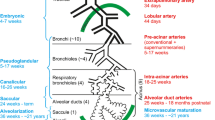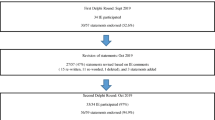Abstract
Development of the posterior neural tube (PNT) in human embryos is a complicated process that involves both primary and secondary neurulation. Because normal development of the PNT is not fully understood, pathogenesis of spinal neural tube defects remains elusive. To clarify the mechanism of PNT development, we histologically examined 20 human embryos around the stage of posterior neuropore closure and found that the developing PNT can be divided into three parts: 1) the most rostral region, which corresponds to the posterior part of the primary neural tube, 2) the junctional region of the primary and secondary neural tubes, and 3) the caudal region, which emerges from the neural cord. In the junctional region, the axially-condensed mesenchyme (AM) intervened between the neural plate/tube and the notochord at the stage of posterior neuropore closure, while the notochord was directly attached to the neural plate/tube in the most rostral region. A single cavity was found to be formed in the AM as the presumptive luminal surface cells were radially aligned in the junctional region prior to the formation of the neural cord. The single cavity was continuous with the central cavity of the primary neural tube. In contrast, multiple or isolated cavities were frequently observed in the caudal region of the PNT. Our observation suggests that the junctional region of the PNT is distinct from other regions in terms of the relationship with the notochord and the mode of cavitation during secondary neurulation.








Similar content being viewed by others
References
Bolli VP (1966) Sekundäre Lumenbildungen in Neuralrohr und Rückenmark menschlicher Embryonen. Acta Anat 64:48–81
Chapman DL, Papaioannou VE (1998) Three neural tubes in mouse embryos with mutations in the T-box gene Tbx6. Nature 391:695–697
Colas JF, Schoenwolf GC (2001) Towards a cellular and molecular understanding of neurulation. Dev Dyn 221:117–145
Criley BB (1969) Analysis of embryonic sources and mechanisms of development of posterior levels of chick neural tubes. J Morphol 128:465–501
Deng C, Bedford M, Li C, Xu X, Yang X, Dunmore J, Leder P (1997) Fibroblast growth factor receptor-1 (FGFR-1) is essential for normal neural tube and limb development. Dev Biol 185:42–54
Dryden RJ (1980) Duplication of the spinal cord: a discussion of the possible embryogenesis of diplomyelia. Dev Med Child Neurol 22:234–243
Epeldegui M, Pena-Melian A, Varela-Moreiras G, Perez-Miguelsanz J (2002) Homocysteine modifies development of neurulation and dorsal root ganglia in chick embryos. Teratology 65:171–179
Galceran J, Farinas I, Depew MJ, Clevers H, Grosschedl R (1999) Wnt3a-/--like phenotype and limb deficiency in Lef1(-/-)Tcf1(-/-) mice. Genes Dev 13:709–717
Griffith CM, Wiley MJ, Sanders EJ (1992) The vertebrate tail bud: three germ layers from one tissue. Anat Embryol (Berl) 185:101–113
Honein MA, Paulozzi LJ, Mathews TJ, Erickson JD, Wong LY (2001) Impact of folic acid fortification of the US food supply on the occurrence of neural tube defects. JAMA 285:2981–2986
Hughes AF, Freeman RB (1974) Comparative remarks on the development of the tail cord among higher vertebrates. J Embryol Exp Morphol 32:355–363
Lemire RJ (1969) Variations in development of the caudal neural tube in human embryos (Horizons XIV-XXI). Teratology 2:361–369
Lemire RJ (1988) Neural tube defects. JAMA 259:558–562
Lendon RG, Emery JL (1970) Forking of the central canal in the equinal cord of children. J Anat 106:499–505
Little J, Elwood JM (1992) Geographical variation. In: Elwood JM, Little J, Elwood JH (eds) Epidemiology and control of neural tube defects. Oxford University Press, New York, pp 96–146
Matsunaga E, Shiota K (1977) Holoprosencephaly in human embryos: epidemiologic studies of 150 cases. Teratology 16:261–272
Müller F, O’Rahilly R (1986) The development of the human brain and the closure of the rostral neuropore at stage 11. Anat Embryol (Berl) 175:205–222
Müller F, O’Rahilly R (1987) The development of the human brain, the closure of the caudal neuropore, and the beginning of secondary neurulation at stage 12. Anat Embryol (Berl) 176:413–430
Müller F, O’Rahilly R (1988) The development of the human brain from a closed neural tube at stage 13. Anat Embryol (Berl) 177:203–224
Nait-Oumesmar B, Stecca B, Fatterpekar G, Naidich T, Corbin J, Lazzarini RA (2002) Ectopic expression of Gcm1 induces congenital spinal cord abnormalities. Development 129:3957–3964
Nakatsu T, Uwabe C, Shiota K (2000) Neural tube closure in humans initiates at multiple sites: evidence from human embryos and implications for the pathogenesis of neural tube defects. Anat Embryol (Berl) 201:455–466
Nievelstein RA, Hartwig NG, Vermeij-Keers C, Valk J (1993) Embryonic development of the mammalian caudal neural tube. Teratology 48:21–31
Nishimura H (1975) Prenatal versus postnatal malformations based on the Japanese experience on induced abortions in the human being. In: Blandau RJ (ed) Aging gametes. Karger, Basel, pp 349–368
O’Rahilly R, Müller F (1987) Developmental stages in human embryos: including a revision of Streeter’s “Horizons” and a survey of the Carnegie collection. Carnegie Institution of Washington publication, Washington, DC
O’Rahilly R, Müller F (1994) Neurulation in the normal human embryo. Ciba Found Symp 181:70–82; discussion 82–79
O’Rahilly R, Müller F (2003) Somites, spinal ganglia, and centra. Enumeration and interrelationships in staged human embryos, and implications for neural tube defects. Cells Tissues Organs 173:75–92
Rosenquist TH, Ratashak SA, Selhub J (1996) Homocysteine induces congenital defects of the heart and neural tube: effect of folic acid. Proc Natl Acad Sci USA 93:15227–15232
Saraga-Babic M, Sapunar D, Wartiovaara J (1995) Variations in the formation of the human caudal spinal cord. J Hirnforsch 36:341–347
Schoenwolf GC (1979) Histological and ultrastructural observations of tail bud formation in the chick embryo. Anat Rec 193:131–147
Schoenwolf GC (1984) Histological and ultrastructural studies of secondary neurulation in mouse embryos. Am J Anat 169:361–376
Schoenwolf GC, Delongo J (1980) Ultrastructure of secondary neurulation in the chick embryo. Am J Anat 158:43–63
Shiota K (1991) Development and intrauterine fate of normal and abnormal human conceptuses. Congenit Anom Kyoto 31:67–80
Stevenson RE, Allen WP, Pai GS, Best R, Seaver LH, Dean J, Thompson S (2000) Decline in prevalence of neural tube defects in a high-risk region of the United States. Pediatrics 106:677–683
Williams LJ, Mai CT, Edmonds LD, Shaw GM, Kirby RS, Hobbs CA, Sever LE, Miller LA, Meaney FJ, Levitt M (2002) Prevalence of spina bifida and anencephaly during the transition to mandatory folic acid fortification in the United States. Teratology 66:33–39
Yoshikawa Y, Fujimori T, McMahon AP, Takada S (1997) Evidence that absence of Wnt-3a signaling promotes neuralization instead of paraxial mesoderm development in the mouse. Dev Biol 183:234–242
Acknowledgements
The authors wish to thank the many cooperating obstetricians and acknowledge the contribution of past and present staff of the Congenital Anomaly Research Center and the Department of Anatomy, Kyoto University, in establishing the Kyoto Collection of Human Embryos. This work was supported by grants from the Japanese Ministries of Health, Labor and Welfare, and of Education, Culture, Sports, Science and Technology.
Author information
Authors and Affiliations
Corresponding author
Rights and permissions
About this article
Cite this article
Saitsu, H., Yamada, S., Uwabe, C. et al. Development of the posterior neural tube in human embryos. Anat Embryol 209, 107–117 (2004). https://doi.org/10.1007/s00429-004-0421-2
Accepted:
Published:
Issue Date:
DOI: https://doi.org/10.1007/s00429-004-0421-2




